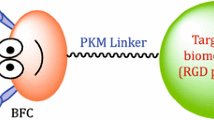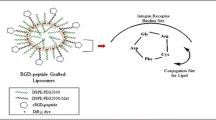Abstract
Purpose
Integrins, especially αvβ3 and αvβ5, are upregulated in tumor cells and activated endothelial cells and as such, serve as cancer biomarkers. We developed a novel near-infrared-labeled optical agent for the in vivo detection and quantification of αvβ3/αvβ5.
Procedures
A small peptidomimetic αvβ3 antagonist was synthesized, coupled to a near-infrared fluorescent (NIRF) dye, and tested for binding specificity using integrin-overexpressing cells, inhibition of vitronectin-mediated cell attachment, binding to tumor and endothelial cells in vitro, and competition studies. Pharmacokinetics, biodistribution, specificity of tumor targeting, and the effect of an antiangiogenic treatment were assessed in vivo.
Results
The integrin NIRF agent showed strong selectivity towards αvβ3/αvβ5 in vitro and predominant tumor distribution in vivo, allowing noninvasive and real-time quantification of integrin signal in tumors. Antiangiogenic treatment significantly inhibited integrin signal in vivo but had no effect on a cathepsin-cleavable NIR agent. Simultaneous imaging revealed different patterns of distribution reflecting the underlying differences in integrin and cathepsin biology during tumor progression.
Conclusions
NIRF-labeled integrin antagonists allow noninvasive molecular fluorescent imaging and quantification of tumors in vivo, improving and providing more refined approaches for cancer detection and treatment monitoring.







Similar content being viewed by others
References
Ruoslahti E (1996) RGD and other recognition sequences for integrins. Annu Rev Cell Dev Biol 12:697–715
Lu X, Lu D, Scully MF et al (2008) The role of integrin-mediated cell adhesion in atherosclerosis: pathophysiology and clinical opportunities. Curr Pharm Des 14:2140–2158
Stupack DG (2007) The biology of integrins. Oncology 21:6–12
Hood JD, Cheresh DA (2002) Role of integrins in cell invasion and migration. Nat Rev Cancer 2:91–100
Friedlander M, Theesfeld CL, Sugita M et al (1996) Involvement of integrins αvß3 and αv ß5 in ocular neovascular diseases. Proc Natl Acad Sci USA 93:9764–9769
Brooks PC, Clark RA, Cheresh DA (1994) Requirement of vascular integrin alphavbeta3 for angiogenesis. Science 264:569–571
Gasparini G, Brooks PC, Biganzoli E et al (1998) Vascular integrin αvß3: a new prognostic indicator in breast cancer. Clin Cancer Res 4:2625–2634
Vonlaufen A, Wiedle G, Borisch B, Birrer S, Luder P, Imhof BA (2001) Integrin αvß3 expression in colon carcinoma correlates with survival. Mod Pathol 14:1126–1132
Gutheil JC, Campbell TN, Pierce PR et al (2000) Targeted antiangiogenic therapy for cancer using Vitaxin: a humanized monoclonal antibody to the integrin αvβ3. Clin. Cancer Res 6:3056–3061
Mulgrew K, Kinneer K, Yao XT et al (2006) Direct targeting of αvβ3 integrin on tumor cells with a monoclonal antibody, Abegrin™. Mol Cancer Ther 5:3122–3129
Hariharan S, Gustafson D, Holden S et al (2007) Assessment of the biological and pharmacological effects of the αvβ3 and αvβ5 integrin receptor antagonist, cilengitide (EMD 121974), in patients with advanced solid tumors. Ann Onc 18:1400–1407
Haubner R, Wester HJ (2004) Radiolabeled tracers for imaging of tumor angiogenesis and evaluation of anti-angiogenic therapies. Curr Pharm Des 10:1439–1455
Dijkgraaf I, Beer AJ, Wester HJ (2009) Application of RGD-containing peptides as imaging probes for alphavbeta3 expression. Front Biosci 14:887–899
Chen X, Park R, Tohme M, Shahinian AH, Bading JR, Conti PS (2004) MicroPET and autoradiographic imaging of breast cancer αv-integrin expression using 18F- and 64Cu-labeled RGD peptide. Bioconjug Chem 15:41–49
Chen X, Park R, Shahinian AH et al (2004) 18F-labeled RGD peptide: initial evaluation for imaging brain tumor angiogenesis. Nucl Med Biol 31:179–189
Haubner R, Wester HJ, Weber WA et al (2001) Noninvasive imaging of αvβ3 integrin expression using 18F-labeled RGD-containing glycopeptide and positron emission tomography. Cancer Res 61:1781–1785
Janssen ML, Oyen WJ, Dijkgraaf I et al (2002) Tumor targeting with radiolabeled αvβ3 integrin binding peptides in a nude mouse model. Cancer Res 62:6146–6151
Massoud TF, Gambhir SS (2003) Molecular imaging in living subjects: seeing fundamental biological processes in a new light. Genes & Dev 17:545–580
Leong-Poi H, Christiansen J, Klibanov AL, Kaul S, Lindner JR (2003) Noninvasive assessment of angiogenesis by ultrasound and microbubbles targeted to αv integrins. Circulation 107:455–460
Ellegala DB, Leong-Poi H, Carpenter JE et al (2003) Imaging tumor angiogenesis with contrast ultrasound and microbubbles targeted to αvβ3. Circulation 108:336–341
Sipkins DA, Cheresh DA, Kazemi M, Nevin LM, Bednarski MD, Li KCP (1998) Detection of tumor angiogenesis in vivo by alphavbeta3-targeted magnetic resonance imaging. Nat Med 4:623–626
Jin ZH, Josserand V, Foillard S et al (2007) In vivo optical imaging of integrin alphaV-beta3 in mice using multivalent or monovalent cRGD targeting vectors. Mol Cancer 12:41–49
Wu Y, Cai W, Chen X (2006) Near-infrared fluorescence imaging of tumor integrin αvβ3 expression with Cy7-labeled RGD multimers. Mol Imaging Biol 8:226–236
Chen X, Conti PS, Moats RA (2004) In vivo near-infrared fluorescence imaging of integrin alphavbeta3 in brain tumor xenografts. Cancer Res 64:8009–8014
Cheng Z, Wu Y, Xiong Z, Gambhir SS, Chen X (2005) Near-infrared fluorescent RGD peptides for optical imaging of integrin alphavbeta3 expression in living mice. Bioconjug Chem 16:1433–1441
Wang W, Ke S, Wu Q et al (2004) Near-infrared optical imaging of integrin alphavbeta3 in human tumor xenografts. Mol Imaging 3:343–351
Hsu AR, Hou LC, Veeravagu A, Greve JM, Vogel H, Tse V, Chen X (2006) In vivo near-infrared fluorescence imaging of integrin alphavbeta3 in an orthotopic glioblastoma model. Mol Imaging Biol 8:315–323
Cai W, Chen K, Li ZB, Gambhir SS, Chen X (2007) Dual-function probe for PET and near-infrared fluorescence imaging of tumor vasculature. J Nucl Med 48:1862–1870
Ntziachristos V, Ripoll J, Wang LV, Weissleder R (2005) Looking and listening to light: the evolution of whole-body photonic imaging. Nat Biotechnol 23:313–320
Graves EE, Ripoll J, Weissleder R, Ntziachristos VA (2003) Submillimeter resolution fluorescence molecular imaging system for small animal imaging. Med Phys 30:901–911
Montet X, Ntziachristos V, Grimm J, Weissleder R (2005) Tomographic fluorescence mapping of tumor targets. Cancer Res 65:6330–6336
Montet X, Figueiredo JL, Alencar H, Ntziachristos V, Mahmood U, Weissleder R (2007) Tomographic fluorescence of tumor vascular volume in mice. Radiology 242:751–758
Nahrendorf M, Sosnovik DE, Waterman P et al (2007) Dual channel optical tomographic imaging of leukocyte recruitment and protease activity in the healing myocardial infarct. Circ Res 100:1218–1225
Kos J, Lah TT (1998) Cysteine proteinases and their endogenous inhibitors: target proteins for prognosis, diagnosis and therapy in cancer. Oncol Rep 5:1349–1361
Coleman PJ, Brashear KM, Askew BC et al (2004) Nonpeptide αvβ3 Antagonists. Part11: discovery and preclinical evaluation of potent αvβ3 antagonists for the prevention and treatment of osteoporosis. J Med Chem 47:4829–4837
Wang J, Breslin MJ, Coleman PJ et al (2004) Non-peptide αvβ3 antagonists. Part 7: 3-Substituted tetrahydro-[1,8]naphthyridine derivatives. Bioorg Med Chem Lett 14:1049–1052
Simon KO, Nutt EM, Abraham DG, Rodan GA, Duong LT (1997) The alphavbeta3 integrin regulates alpha5beta1-mediated cell migration toward fibronectin. J Biol Chem 272:29380–29389
Landegren U (1984) Measurement of cell numbers by means of the endogenous enzyme hexosaminidase. Applications to detection of lymphokines and cell surface. antigens. J. Immunol. Methods 67:379–388
Rust WL, Carper SW, Plopper GE (2002) The promise of integrins as effective targets for anticancer agents. J Biomed Biotech 2:124–130
Reardon DA, Fink KL, Mikkelsen T et al (2008) Randomized phase II study of cilengitide, an integrin-targeting arginine-glycine-aspartic acid peptide, in recurrent glioblastoma multiforme. J Clin Onc 26:5610–5617
Burnett CA, Xie J, Quijano J et al (2005) Synthesis, in vitro, and in vivo characterization of an integrin alpha(v)beta(3)-targeted molecular probe for optical imaging of tumor. Bioorg Med Chem 13:3763–3771
Achilefu S, Bloch S, Markiewicz MA et al (2005) Synergistic effects of light-emitting probes and peptides for targeting and monitoring integrin expression. Proc Natl Acad Sci USA 102:7976–7981
Aina OH, Marik J, Gandour-Edwards R, Lam KS (2005) Near-infrared optical imaging of ovarian cancer xenografts with novel alpha 3-integrin binding peptide “OA02”. Mol Imaging 4:439–447
Li C, Wang W, Wu Q et al (2006) Dual optical and nuclear imaging in human melanoma xenografts using a single targeted imaging probe. Nucl Med Biol 33:349–358
Humphries JD, Byron A, Humphries MJ (2006) Integrin ligands at a glance. J Cell Sci 119:3901–3903
Montet X, Funovics M, Montet-Abou K et al (2006) Multivalent effects of RGD peptides obtained by nanoparticle display. J Med Chem 49:6087–6093
Takagi J, Petre BM, Walz T, Springer TA (2002) Global conformational rearrangements in integrin extracellular domains in outside-in and inside-out signaling. Cell 110:599–611
Adair BD, Xiong J-P, Maddock C, Goodman SL, Arnaout MA, Yeager M (2005) Three-dimensional EM structure of the ectodomain of integrin alphaV-beta3 in a complex with fibronectin. J Cell Biol 168:1109–1118
Xiong JP, Stehle T, Zhang R et al (2002) Crystal structure of the extracellular segment of integrin αVβ3 in complex with an Arg-Gly-Asp ligand. Science 296:151–155
Bednar B, Cunningham ME, McQueney PA et al (1997) Flow cytometric measurement of kinetic and equilibrium binding parameters of arginine-glycine-aspartic acid ligands in binding to glycoprotein IIb/IIIa on platelets. Cytometry 28:58–65
Sloan EK, Pouliot N, Stanley KL et al (2006) Tumor specific expression of αvβ3 integrin promotes spontaneous metastasis of breast cancer to bone. Breast Cancer Res 8:1–14
Cooper CR, Chay CH, Pienta KJ (2002) The role of alpha(v)beta(3) in prostate cancer progression. Neoplasia 4:191–194
Bakewell SJ, Nestor P, Prasad S et al (2003) Platelet and osteoclast beta3 integrins are critical for bone metastasis. Proc Natl Acad Sci USA 100:14205–14210
Carmeliet P, Jain RK (2000) Angiogenesis in cancer and other diseases. Nature 407:249–257
Presta LG, Chen H, O’Connor SJ et al (1997) Humanization of an anti-vascular endothelial growth factor monoclonal antibody for the therapy of solid tumors and other disorders. Cancer Res 57:4593–4599
Sadeghi MM, Krassilnikova S, Zhang J et al (2004) Detection of injury-induced vascular remodeling by targeting activated avb3 integrin in vivo. Circulation 110:84–90
Bednar B, Lin SH, Gaspar R et al (2008) In vivo imaging detection of cathepsin activity and angiogenesis in mouse models of atherosclerosis. Abstract 2051 World Molecular Imaging Congress, Nice, France, September 10–14
Author information
Authors and Affiliations
Corresponding author
Additional information
This study conclusively establishes for the first time the ability to simultaneously and noninvasively quantify integrin αvβ3 and cathepsin activity using near-infrared fluorescence tomography in vivo.
Rights and permissions
About this article
Cite this article
Kossodo, S., Pickarski, M., Lin, SA. et al. Dual In Vivo Quantification of Integrin-targeted and Protease-activated Agents in Cancer Using Fluorescence Molecular Tomography (FMT). Mol Imaging Biol 12, 488–499 (2010). https://doi.org/10.1007/s11307-009-0279-z
Received:
Revised:
Accepted:
Published:
Issue Date:
DOI: https://doi.org/10.1007/s11307-009-0279-z




